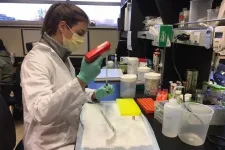(Press-News.org) In a SWOG Cancer Research Network trial that put three targeted drugs to the test, the small molecule inhibitor cabozantinib was found most effective in treating patients with metastatic papillary kidney cancer - findings expected to change medical practice.
These findings will be presented at ASCO's virtual 2021 Genitourinary Cancers Symposium on Feb. 13, 2021 at 1 p.m. ET. The findings will be simultaneously published in The Lancet.
There are currently no effective treatments for metastatic papillary kidney cancer, or metastatic pRCC, a rare subtype of kidney cancer. One study of 38 patients found that the average survival rate was eight months after diagnosis.
Sumanta Pal, MD, clinical professor of medical oncology at City of Hope, a comprehensive cancer center, and an investigator at SWOG, a cancer clinical trials group funded by the National Cancer Institute (NCI), part of the National Institutes of Health (NIH), said there is hope for metastatic papillary kidney cancer patients. Mutations in the MET gene are a hallmark of this type of cancer, and there are new drugs that target the MET gene among other important signaling pathways. Pal decided to put three of them to the test against the current standard treatment, sunitinib, a receptor tyrosine inhibitor.
In his study, S1500, Pal studied 147 eligible patients with papillary kidney cancer, most of whom had not received any prior treatment. Patients were randomly assigned to one of four treatment groups - those who took sunitinib and those who took one of the three MET target drugs - cabozantinib, crizotinib, and savolitinib.
Pal and his team wanted to see how long it would take patients' cancer to spread or return, a measure known as progression-free survival. What they found: Patients receiving sunitinib went a median of 5.6 months before their cancer progressed; patients receiving savolitinib and crizotinib fared much worse overall. But cabozantinib, which inhibits VEGF receptors and AXL in addition to MET, gave patients a median of 9.2 months before their cancer progressed. In addition, 23% of patients had a significant reduction in the size of their tumor with cabozantinib. In contrast, only 4% of patients saw this kind of tumor response with sunitinib.
"The magnitude of the response was surprising," Pal said. "We still have a long way to go to help make patients' lives longer and better, but we do have a new standard treatment for these rare cancer patients. This result is a testament to SWOG and to City of Hope, who have the motivation and expertise needed to successfully conduct rare cancer clinical trials."
Building on the momentum of S1500, SWOG will lead the next pivotal trial in papillary kidney cancer, one with a focus on the potential synergy between targeted treatments like cabozantinib and immune therapy. Pal will lead that study with SWOG investigator Dr. Benjamin Maughan at Huntsman Cancer Institute at the University of Utah.
SWOG 1500, also called PAPMET, was sponsored by NCI, designed and led by the SWOG Cancer Research Network under the leadership of Dr. Pal, and conducted through the NCI's National Clinical Trials Network.
S1500 was also funded by the NIH through NCI grants CA180888, CA180819, CA180820, CA180821, CA180863, and CA180868; and in part by AstraZeneca plc/AB, Exelixis, Inc., and Pfizer, Inc. The companies provided savolitinib, cabozantinib, crizotinib, and sunitinib, respectively, for the trial under each company's Cooperative Research and Development Agreement with the NCI.
"NCI's drug development program in the Cancer Therapy Evaluation Program facilitated the collaborations between pharmaceutical companies as well as collaborations between companies and SWOG investigators to make this trial possible. We are proud to have played a part in defining which of these therapies is most effective for patients with papillary renal cell carcinoma," said John Wright, MD, PhD, the associate branch chief of CTEP's Investigational Drug Branch, and the NCI's medical monitor for the study.
INFORMATION:
Pal's S1500 study team includes Catherine Tangen, DrPH, of the SWOG Statistics and Data Management Center; Ian M. Thompson, Jr., MD, of CHRISTUS Santa Rosa; Naomi Balzer-Haas, MD, of Abramson Cancer Center; Daniel J. George, of Duke University Medical Center; Daniel Y.C. Heng, MD, of Tom Baker Cancer Center; Brian Shuch, MD, of Institute of Urologic Oncology at UCLA; Mark Stein, MD, of Columbia University; Maria Tretiakova, MD, PhD, of University of Washington; Peter Humphrey, MD, of Yale University; Adebowale Adeniran, MD, of Yale University; Vivek Narayan, MD, MS, of Abramson Cancer Center; Georg A. Bjarnason, MD, of Sunnybrook Odette Cancer Centre; Ulka Vaishampayan, MBBS, of Wayne State University and University of Michigan; Ajjai Alva, MBBS, of University of Michigan; Tian Zhang, MD, of Duke Cancer Research Institute; Scott Cole, MD, of Oklahoma Cancer Specialists and Research Institute; Melissa Plets, MS, of the SWOG Statistics and Data Management Center; John Wright, MD, PhD, and Primo N. Lara, Jr. MD, of UC Davis Comprehensive Cancer Center.
SWOG Cancer Research Network is part of the National Cancer Institute's National Clinical Trials Network and the NCI Community Oncology Research Program, and is part of the oldest and largest publicly-funded cancer research network in the nation. SWOG has nearly 12,000 members in 47 states and eight foreign countries who design and conduct clinical trials to improve the lives of people with cancer. SWOG trials have led to the approval of 14 cancer drugs, changed more than 100 standards of cancer care, and saved more than 3 million years of human life. Learn more at swog.org.
City of Hope is an independent biomedical research and treatment center for cancer, diabetes and other life-threatening diseases. Founded in 1913, City of Hope is a leader in bone marrow transplantation and immunotherapy such as CAR T cell therapy. City of Hope's translational research and personalized treatment protocols advance care throughout the world. Human synthetic insulin, monoclonal antibodies and numerous breakthrough cancer drugs are based on technology developed at the institution. AccessHopeTM, a wholly owned subsidiary, was launched in 2019 and is dedicated to serving employers and their health care partners by providing access to City of Hope's exceptional cancer expertise. A National Cancer Institute-designated comprehensive cancer center and a founding member of the National Comprehensive Cancer Network, City of Hope is ranked among the nation's "Best Hospitals" in cancer by U.S. News & World Report. Its main campus is located near Los Angeles, with additional locations throughout Southern California and in Arizona. For more information about City of Hope, follow us on Facebook, Twitter, YouTube or Instagram.
Lenvatinib plus pembrolizumab yields better overall survival than single-agent sunitinib when given as first-line therapy in untreated patients with metastatic kidney cancer
The combination also improved progression-free survival and overall response rate
BOSTON - Patients with advanced kidney cancer, who received a targeted drug combined with a checkpoint-blocker immunotherapy agent had longer survival than patients treated with the standard targeted drug, said an investigator from Dana-Farber Cancer Institute, reporting results from a phase 3 clinical trial.
The survival benefit demonstrates that an immune checkpoint inhibitor together with a targeted kinase inhibitor drug "is important ...
A test that monitors blood levels of DNA fragments released by dying tumor cells may serve as an accurate early indicator of treatment success in people in late stages of one of the most aggressive forms of skin cancer, a new study finds.
Led by NYU Grossman School of Medicine and Perlmutter Cancer Center researchers, the investigation looked at adults with undetectable levels of freely circulating tumor DNA (ctDNA) four weeks into drug treatment for metastatic melanoma tumors that cannot be removed surgically (unresectable). The study showed that these patients, all of whom had common genetic changes (BRAFV600 mutations) linked to cancer, were living ...
Peer-reviewed / Review, Survey and Opinion piece
To ensure an effective global immunisation strategy against COVID-19, vaccines need to be produced at scale, priced affordably, and allocated globally so that they are available where needed, and successfully rolled out.
Review of evidence includes a comparison of 26 leading vaccines on their potential contribution to achieving global vaccine immunity, and a new survey of COVID-19 vaccine confidence in 32 countries.
Having new COVID-19 vaccines will mean little if people around the world are unable to get vaccinated in a timely manner. ...
A new study from Washington University School of Medicine in St. Louis demonstrates that a liquid biopsy examining blood or urine can help gauge the effectiveness of therapy for colorectal cancer that has just begun to spread beyond the original tumor. Such a biopsy can detect lingering disease and could serve as a guide for deciding whether a patient should undergo further treatments due to some tumor cells evading an initial attempt to eradicate the cancer.
The study appears online Feb. 12 in the Journal of Clinical Oncology Precision Oncology, a journal of the American Society of Clinical Oncology.
While a few liquid biopsies have been approved ...
FOR IMMEDIATE RELEASE
Scientists have yet to answer the age-old question of whether or how sound shapes the minds of fetuses in the womb, and expectant mothers often wonder about the benefits of such activities as playing music during pregnancy. Now, in experiments in newborn mice, scientists at Johns Hopkins report that sounds appear to change "wiring" patterns in areas of the brain that process sound earlier than scientists assumed and even before the ear canal opens.
The current experiments involve newborn mice, which have ear canals that open 11 days after birth. In human fetuses, the ear canal opens prenatally, at about 20 weeks gestation.
The findings, published online Feb. 12 in END ...
A more aggressive approach to treating acne that marries the disciplines of psychology and dermatology is needed, according to two UC Riverside psychology researchers.
They also assert that women and people with darker skin disproportionately suffer from acne's psychological impacts.
"Acne is pervasive, physically harmless, and painless, so we all-too-often underestimate its impacts as the quintessential nuisance of adolescence and puberty," said UCR psychology professor Misaki Natsuaki, who authored the paper along with Tuppett Yates, also a UCR psychology professor.
The insinuation, including by developmental scientists, can be that hurtful monikers such as "pizza face" and "crater face" are best shrugged off.
But psychological ...
Using observations from NASA's Transiting Exoplanet Survey Satellite (TESS), an international team of astronomers has discovered a trio of hot worlds larger than Earth orbiting a much younger version of our Sun called TOI 451. The system resides in the recently discovered Pisces-Eridanus stream, a collection of stars less than 3% the age of our solar system that stretches across one-third of the sky.
The planets were discovered in TESS images taken between October and December 2018. Follow-up studies of TOI 451 and its planets included observations made in 2019 and 2020 using NASA's Spitzer Space Telescope, ...
Masks help protect the people wearing them from getting or spreading SARS-CoV-2, the virus that causes COVID-19, but now researchers from the National Institutes of Health have added evidence for yet another potential benefit for wearers: The humidity created inside the mask may help combat respiratory diseases such as COVID-19.
The study, led by researchers in the NIH's National Institute of Diabetes and Digestive and Kidney Diseases (NIDDK), found that face masks substantially increase the humidity in the air that the mask-wearer breathes in. This higher level of humidity in inhaled air, the researchers suggest, could help explain why wearing masks has been linked to lower disease severity in people infected with SARS-CoV-2, because hydration of the respiratory ...
A new study published in the journal Science Advances shows that Bantu-speaking communities in the Congo rainforest underwent a major population collapse from 1600 to 1400 years ago, probably due to a prolonged disease epidemic, and that significant resettlement did not restart until around 1000 years ago. These findings revise the population history of no less than seven present-day African countries (Cameroon, Central African Republic, Democratic Republic of the Congo, Republic of the Congo, Gabon, Equatorial Guinea, and Angola) and challenges the commonly held belief that the settlement of Central Africa by Bantu-speaking communities was a continuous process from about 4000 years ago until the start of the transatlantic ...
In research that may eventually help crops survive drought, scientists at Princeton University have uncovered a key reason that mixing material called hydrogels with soil has sometimes proven disappointing for farmers.
Hydrogel beads, tiny plastic blobs that can absorb a thousand times their weight in water, seem ideally suited to serve as tiny underground reservoirs of water. In theory, as the soil dries, hydrogels release water to hydrate plants' roots, thus alleviating droughts, conserving water, and boosting crop yields.
Yet mixing hydrogels into farmers' fields has had spotty results. Scientists have struggled to explain these uneven performances in large part because soil--being opaque --has thwarted attempts at observing, analyzing, and ultimately improving hydrogel ...



